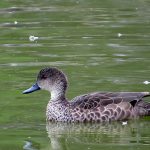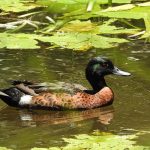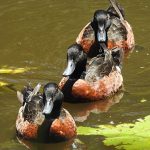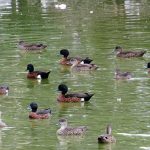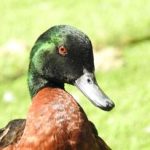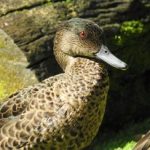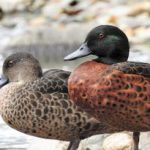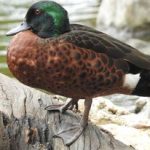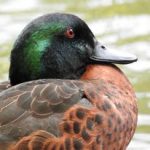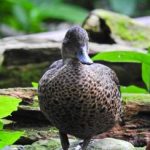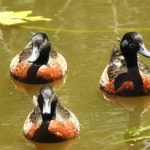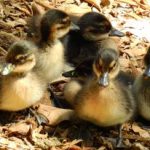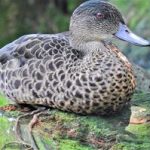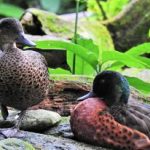CHESTNUT TEAL
(Anas castanea)
The Chestnut Teal, a species of dabbling duck, is a small yet striking member of the Anatidae family, which encompasses the familiar ducks, the stately geese, and the regal swans.
Let us take a closer look at the male Chestnut Teal, a vision of avian elegance. With a head that shines like a polished emerald, this duck boasts a stunning contrast with its rich chestnut-brown underparts and body. A white flank mark and a sleek black stern complete his striking ensemble, ensuring he cuts a dapper figure on the water’s surface. The female, on the other hand, is the very picture of subtlety and sophistication. Her mottled grey-brown plumage, a masterclass in camouflage, allows her to blend seamlessly into the surrounds, a necessary advantage for the protection of her future brood.
These ducks are not just a feast for the eyes; they are masters of their aquatic domains. Whether it’s a serene lake, a meandering river, a hidden swamp, or a coastal estuary, the Chestnut Teal is right at home. With a graceful tipping motion, they dabble below the surface, foraging for a meal of submerged vegetation, insects, and small aquatic creatures that form their diet.
But the Chestnut Teal is not a solitary creature. It is a bird with a voice, contributing to the symphony of the wetlands with an array of whistles and quacks that serve as a language among feathers. These vocalizations are crucial, for they are the threads that weave together the social fabric of these birds, particularly when they gather in mixed flocks with other waterfowl species during the non-breeding season.
When the time comes to continue their lineage, the Chestnut Teal engages in a dance of courtship as old as time. Through a series of head bobbing, neck stretching, and other visual cues, they communicate their intentions and form pair bonds. Nesting is a private affair, with nests carefully constructed in the sheltering embrace of vegetation near water bodies, ensuring the safety and secrecy of their precious eggs.
While the Chestnut Teal is not currently facing a global threat, their story is not without its cautions. Local populations can be vulnerable to the consequences of human actions—habitat degradation, pollution, and the ever-looming shadow of climate change. It is our responsibility to ensure that these ducks, so emblematic of the region’s avian biodiversity, continue to grace our waterways with their presence.
Conservation efforts, therefore, are not just a necessity but a duty. By protecting the natural habitats of the Chestnut Teal, we safeguard a part of our natural heritage, a jewel in the crown of the natural world. Their continued survival is a testament to the delicate balance of ecosystems, and a reminder of the beauty that resides in our own backyard.
In the story of the Chestnut Teal, we find a narrative that is both a celebration of life and a call to action—a reminder that the splendour of nature is ours to cherish and protect, for now and for generations to come.

